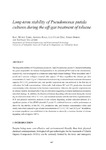Long-term stability of Pseudomonas putida cultures suring the off-gas treatment of toluene

View/
Use this link to cite
http://hdl.handle.net/2183/12840Collections
Metadata
Show full item recordTitle
Long-term stability of Pseudomonas putida cultures suring the off-gas treatment of tolueneDate
2007Citation
Biotechniques for Air Pollution Control II, 2007: 447-456. ISBN: 978-84-9749-258-4
Abstract
[Abstract] The long term stability of Pseudomonas putida mt-2 and Pseudomonas putida F1, bacteria harbouring the genes responsible for toluene biodegradation in the plasmid pWW0 and in the chromosome, respectively, was investigated in a chemostat under high toluene loadings. When inoculated with P. putida mt-2 process collapse occurred after approx 3.5 days regardless the toluene gas inlet concentration (9.1 and 3.2 g m-3). Maximum bacterial activity (evaluated based on toluene elimination capacity (EC), CO2 production rate, and specific respiration rate was achieved at the first day of cultivation for both concentrations. Afterwards, both toluene EC and CO2 production decreased concomitantly with a decrease in the biomass concentration. Likewise, the specific respiration rate on toluene steadily decreased after 1 day of cultivation suggesting a toluene mediated accumulative microbial damage. In addition, the fraction of toluene degrading cells decreased during the second day of cultivation from 100 to 73 ± 4 %, and remained constant until the end of the experimentation. PCR and plasmid restriction analyses of non toluene degrading isolates indicated deletion of a significant portion of the pWW0 plasmid. P. putida F1 exhibited however a stable performance as shown by the stability of the EC, CO2 production rate, and biomass concentration within each steady state when exposed to gas toluene concentrations of 3.3, 6.2, 11.2 and 20.2 g m-3. In addition, no mutant population was established in the chemostat as shown by a constant fraction of toluene degrading cells of approx 100 %.
ISBN
978-84-9749-258-4





